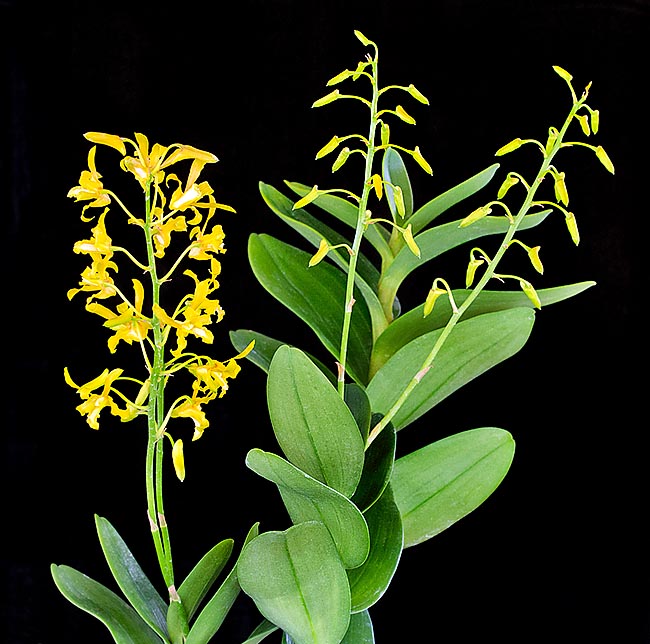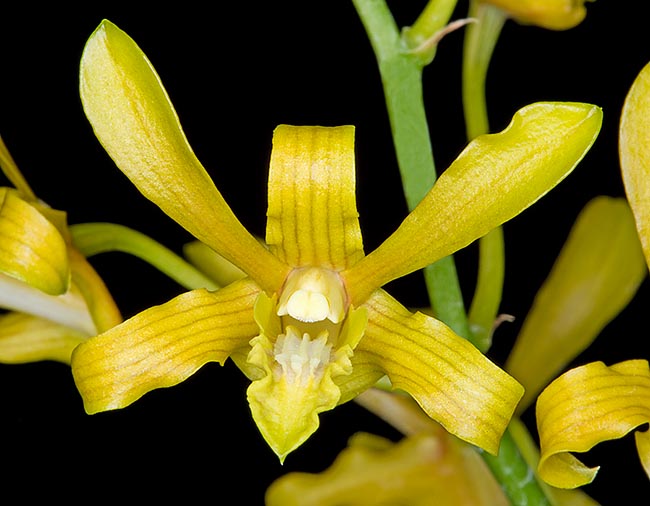Family : Orchidaceae

Text © Pietro Puccio

English translation by Mario Beltramini

Dendrobium sylvanum is an epiphyte with even 120 cm long erect pseudobulbs at home, at low altitude, in the humid forests of Bismarck Archipelago, Solomon Islands, New Caledonia and New Guinea © Giuseppe Mazza
The name of the genus is the combination of the Greek substantives “δένδρον” (dendron) = tree, and “βίος” (bios) = life, with reference to the numerous species of the genus living on the trees; the name of the species is the Latin adjective “sylvanus, a, um” = sylvan, of the woods, with obvious reference.
The Dendrobium sylvanum Rchb.f. (1876) is an epiphytic species with cylindrical erect pseudobulbs, slightly thinned at the apex and at the base, up to about 1,2 m long and of 1-1,5 cm of diameter, provided in the upper half of alternate, distichous, oblong-ovate with bilobed apex, up to 12 cm long and 4 cm broad in the median part, coriaceous, of intense glossy green colour leaves.
Recemose inflorescences from the upper nodes, erect, up to 50 cm long, carrying numerous greenish yellow flowers with more or less intense purple brown striations, of 5-6 cm of diameter, oblong-linear sepals with slightly undulated margin, 2,4 cm long, with retroflexed apices, the lateral sepals, merged at the base of the column, form a sort of a spur (mentum) about 0,7 cm long.
Obovate-spatulate petals, about 3 cm long and 0,7 cm broad, trilobed labellum, 2,4 cm long and 1 cm broad, with oblong erect lateral lobes with toothed margin and oblong median lobe with pointed apex and undulated margins, run at the base by three white parallel lines; the flowers are long lasting, 6-9 weeks. It reproduces by seed, in vitro, and division, to be done by the vegetative restart, with each section provided of at least 3-4 pseudobulbs.
Relatively diffused species in the origin places, but quite rare in cultivation, requires high luminosity, also some hours of direct sun light, medium-high temperatures, 20-32 °C, high humidity, 70-85%, and constant air movement.

The 5-6 cm broad flowers, gathered in erect racemose inflorescences touching 50 cm, last 6-9 weeks © G. Mazza
Cultivable in pots or baskets with particularly draining and aerated compost which may be formed by a mix of medium sliced bark, coir and fragments of charcoal, with possible addition of inerts to improve the drainage, or mounted on bark, trunks, rafts of cork or of arborescent ferns roots.
Transplants and repottings are to be done when strictly necessary by the vegetative restart, signalled by the appearance of the new vegetations.
The species is reported in the appendix II of the CITES (species whose trade is internationally ruled).
Synonyms: Dendrobium prionochilum F.Muell. & Kraenzl. (1894); Dendrobium robustum Rolfe (1895); Dendrobium validum Schltr. (1905); Dendrobium warianum Schltr. (1912); Dendrobium kennedyi Schltr. (1921); Grastidium sylvanum (Rchb.f.) Rauschert (1983); Durabaculum kennedyi (Schltr.) M.A.Clem. & D.L.Jones (2002); Durabaculum prionochilum (F.Muell. & Kraenzl.) M.A.Clem. & D.L.Jones (2002); Durabaculum sylvanum (Rchb.f.) M.A.Clem. & D.L.Jones (2002); Durabaculum validum (Schltr.) M.A.Clem. & D.L.Jones (2002); Durabaculum warianum (Schltr.) M.A.Clem. & D.L.Jones (2002).
→ For general notions about ORCHIDACEAE please click here.
